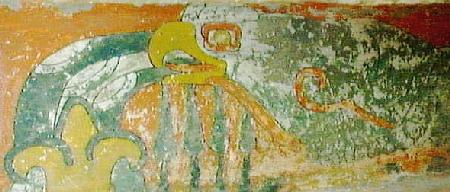
Teotihuacan

Veronika with the Pyramid of the Moon in the background, Teotihuacan
Sunday 29th August 1999
We travelled from Tula to Teotihuacan very early on Sunday morning in order to have a full day at the site. Even so, in six hours we didn't manage to see it all, as the site is so big.
Teotihuacan was the first great civilisation of central Mexico. At its zenith in the 6th century AD, it had a population estimated at 200,000, making it at the time the sixth largest city in the world, and it probably controlled the largest pre-Columbian empire in Mexico, with two-thirds of Mexico, all of Guatemala and Belize, and part of Honduras and El Salvador under its control. The people of Teotihuacan had writing and books, and used the 260-day sacred year later used by the Mayans.
The city was built on a planned grid system, with separate religious, political-administrative, commercial and agricultural districts, and there is some evidence to suggest that there were different quarters for at least some separate ethno-cultural groupings. Construction began around the time of Christ, and the largest building, the Pyramid of the Sun, the third-largest pyramid in the world (after the Pyramid of Cholula in Mexico and the Great Pyramid of Cheops in Egypt) was built in the first 150 years AD.

Sculpture of Quetzalcoatl from the Temple of Quetzalcoatl, Teotihuacan
The site is amazing: better preserved than Tula (although some of it has been reconstructed by modern archaeologists - recent research suggests that in fact the Pyramid of the Sun has been inaccurately reconstructed in parts), and simply massive (the Avenue of the Dead stretches for two kilometres within the archaeological zone, and for several kilometres beyond the perimeter of the zone), it displays many more remnants of the fine decoration which characterised the city. It also has many more visitors (admittedly we visited on a Sunday, when it's free, so many more people visit) and an incredible number of hawkers selling souvenirs, including a couple trying to pass off what they claimed were genuine original pre-Columbian artefacts which were certainly fakes; even if they weren't, since it's illegal to export pre-Columbian artefacts from Mexico they'd have been no use to us unless we decided to risk smuggling them. The hawkers are incredibly persistent and at times annoying in the extreme, but the sheer magnificence of the site means that they become a mere irritation, and saying "No, gracias" becomes just like swatting flies.
Teotihuacan is centred around the Avenue of the Dead, so called because the Aztecs (who like many later peoples revered Teotihuacan as a sacred city) believed that the buildings lining it were tombs built by giants for Teotihuacan's first rulers.

View south from the Pyramid of the Moon, showing the Avenue of the Dead and the Pyramid of the Sun
It's difficult to imagine the impression that Teotihuacan would have made on people at its height, as the many building would have been covered with lime and brightly painted and decorated; few of the decorations remain today, although the facade of the Temple of Quetzalcoatl remains impressive with its carvings of Quetzalcoatl and the rain god Tlaloc.
The Pyramid of the Sun is simply huge - 222 metres (730 feet) on each side, and 70 metres (230 feet) high. Originally it would have been painted bright red, although scant traces of that can be found now. The pyramid contains 3 million tonnes of stone, brick and rubble, and the people who built it had no metal tools, no pack animals, and no wheel! In 1971, archaeologists confirmed the Aztec belief that the pyramid was dedicated to the sun god when they discovered a 100-metre long tunnel running from near the west side of the pyramid to a cave directly beneath the centre of the pyramid; this cave contained religious artefacts. A sense of scale can be gained by looking at the size of the people climbing the pyramid in the picture below.

Fergus in front of the Pyramid of the Sun, Teotihuacan
At the northern end of the Avenue of the Dead lies the Pyramid of the Moon. It is not as big as the Pyramid of the Sun, but it is just as impressive, perhaps more so with its 12 mini-pyramid platforms around the Plaza of the Moon. To the south-west of the Plaza of the Moon lie the Palace of the Quetzal Butterfly (Quetzalpapalotl) and beneath that the Palace of the Jaguars and the Temple of the Plumed Conches. Parts of these have been well restored, and they also contain some of the best-preserved murals in Teotihuacan, giving some indication of the splendour that must have been evident when the site was at its peak.

Detail of a mural showing the bright colours which decorated most of Teotihuacan
Mexico index | Travel index | Family history | Romany | Main index